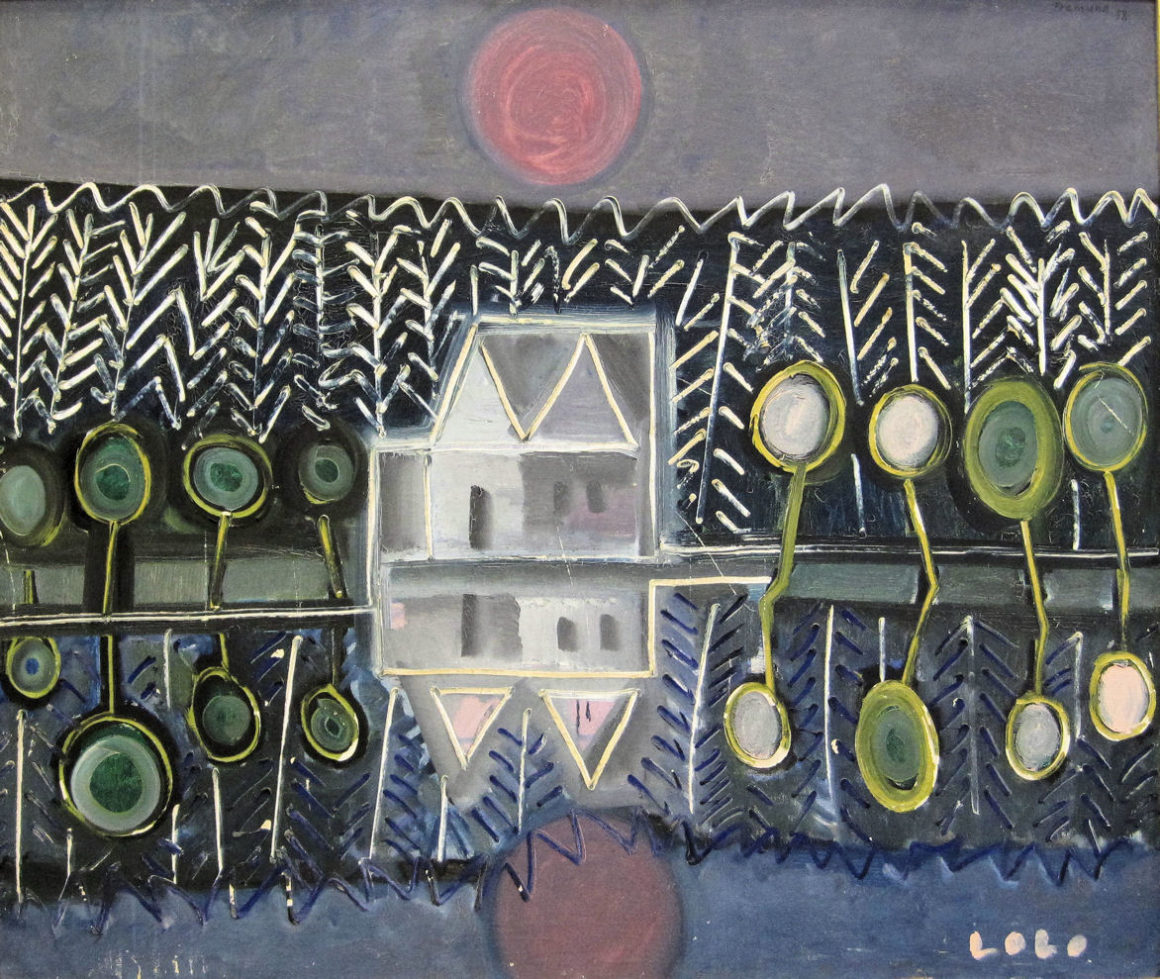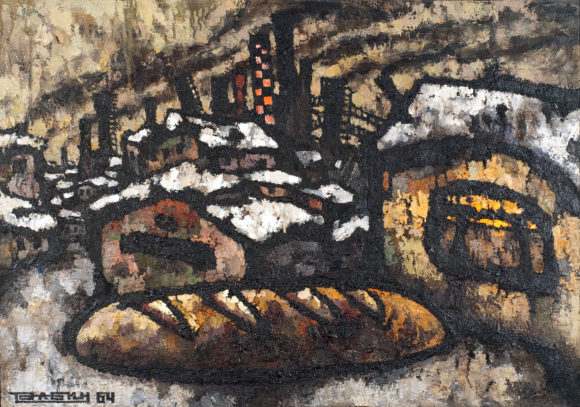
16 Dec Under the Iron Curtain: Modern Art from the Soviet Bloc
On view December 16, 2012–March 31, 2013
Read the exhibition brochure online here
The works in Under the Iron Curtain: Modern Art from the Soviet Bloc by 19 artists exemplify a cross-section of styles and movements that defined the progression of modern art in the Eastern Bloc during and after the Thaw − Nikita Khrushchev’s de-Stalinization efforts that began after the death of the Soviet Premier in 1953. During the Thaw, Stalin’s terror tactics were denounced and many censorship policies and restrictions were loosened, ushering in a period of greater artistic freedom and expression.
The Gilbert Pavilion Gallery will feature official artists of the era, while the Derfner Judaica Museum will feature a diverse array of artists working in styles that pushed the boundaries of Socialist Realism – the government-sanctioned “official” art style – to varying degrees during and after the Thaw throughout the Eastern Bloc.
About the Artists
The artists whose work is featured in the Museum range from the patently dissident – for example, Richard Fremund (Czech, 1928-1969) of the May 57 Group in Prague and Oscar Rabin (Russian, b. 1928), a Nonconformist based in Moscow – to those working in the “Severe Style,” such as Anatoli Nikich (Russian, 1918-1994) and Piotr Ossovsky (Russian, b. 1925). The latter continued to adhere to Socialist Realist principles while presenting a more personal and less idealized view of everyday life.
In addition to Rabin, Fremund, Ossovsky and Nikich, artists represented in the Museum include Nonconformist Grisha Bruskin (Russian, b. 1945), Gyula Konfar (Hungarian, 1933-2008), and Solomon Gershov (Russian, 1906-1989), who worked in an expressionistic style often portraying Jewish themes, and who was arrested twice for his criticism of the Artist’s Union under Stalin.
Among the works by official artists that will be on view in the Gilbert Pavilion are cityscapes highlighting popular sites and landmarks, which were a frequent theme. Elena Kamenetskaya (Russian, b. 1918), Mikhail Matorin (Russian, 1906-1976), Meer Akselrod (Russian, 1902-1970) and Vasily Sigorsky (Russian, 1902-1978) depicted such views in deftly executed watercolors and gouaches. Under the Iron Curtain also features master watercolorist Antonina Romodanovskaya’s, At the Exhibition of Achievements of the National Economy (1959), which is set against the official, government-sanctioned exhibition that celebrated the accomplishments of Soviet industry and culture. It provides the most overt example of Socialist Realism in this exhibition.
Locations outside of major Russian cities are also represented, as painted by Albert Papikian (Armenian, 1926-1997) in Aragats (1962) and Aram Kupestian (Russian, b. 1928) in Mountains in Garni (1963) – both mountain ranges in Armenia. Vladimir Gedikyan’s (Russian, b. 1928) work, A Tale of the Northern Urals (1962), reflects the widespread attraction to traveling North during the Thaw to destinations that existed beyond the boundaries of large cities, akin to a new frontier. George Khrapak’s (Russian, b. Ukraine, 1922-1974) work in tempera, Bakhchysarai (1963) depicts an urban settlement in the south of the Ukraine. Khrapak was arrested in 1948 and spent nearly five years in prison; after he was released, he was able to clear his name during the Thaw like many other artists that had been unjustly imprisoned under Stalin’s regime.
Three gouaches are on view by I. Belopolskaya and Solovieva-Fateeva (Galina Solovieva, Russian, 1908-1984 and Irina Anatolièvna Fateeva, Ukrainian, 1908-1981), one of which depicts the classic Russian folktale, The Enormous Turnip. Many artists also worked as illustrators for books and other commercial media.

Oscar Rabin (Russian, b. 1928), Bread and Factory, 1964, oil on canvas, 28 x 39 inches, The Art Collection of The Hebrew Home at Riverdale
All of the works in the exhibition were acquired from Grosvenor Gallery in London in the mid-1970s. Founded in 1960 by eminent art collector Eric Estorick and his wife, Salome – also known for their collection of Italian Futurist art – the gallery was a premier exhibition venue for many little known Eastern European artists, both “dissident” and official. Rabin’s first solo show took place at Grosvenor in 1965 (Bread and Factory, 1964, pictured above, was included in that exhibition). Estorick was born in New York City in 1913, his family having emigrated from Russia to the United States in 1905 to escape anti-Semitism. After growing up in Brooklyn, Estorick became a political writer and lecturer in sociology at New York University. His interest in contemporary art began with his introduction to photographer Alfred Stieglitz’s 291 Gallery – one of the first venues in New York to exhibit important European avant-garde artists. Estorick died in London in 1993.
All of the works in the exhibition were acquired from Grosvenor Gallery in London in the mid-1970s. Founded in 1960 by eminent art collector Eric Estorick and his wife, Salome – also known for their collection of Italian Futurist art – the gallery was a premier exhibition venue for many little known Eastern European artists, both “dissident” and official. Rabin’s first solo show took place at Grosvenor in 1965 (Bread and Factory, 1964, was included in that exhibition). Estorick was born in New York City in 1913, his family having emigrated from Russia to the United States in 1905 to escape anti-Semitism. After growing up in Brooklyn, Estorick became a political writer and lecturer in sociology at New York University. His interest in contemporary art began with his introduction to photographer Alfred Stieglitz’s 291 Gallery – one of the first venues in New York to exhibit important European avant-garde artists. Estorick died in London in 1993.
![]() This exhibition is supported, in part, by public funds from the New York City Department of Cultural Affairs in partnership with the City Council.
This exhibition is supported, in part, by public funds from the New York City Department of Cultural Affairs in partnership with the City Council.
Featured image: Richard Fremund (Czech, 1928-1969), Mill in the Woods, 1958, oil on canvas, 35 x 45 ½ in., The Art Collection of The Hebrew Home at Riverdale

